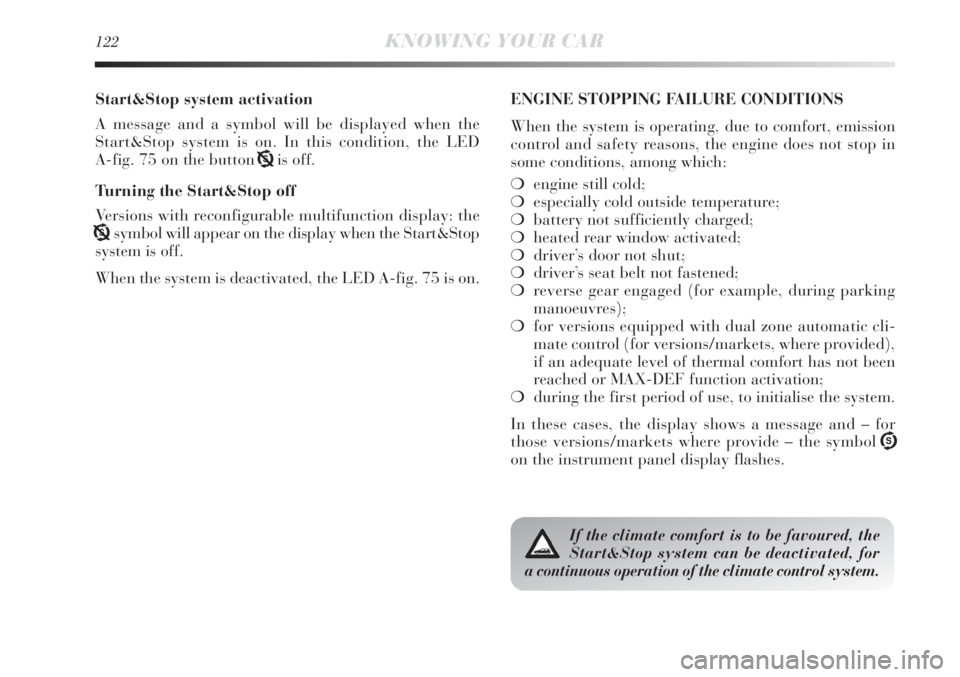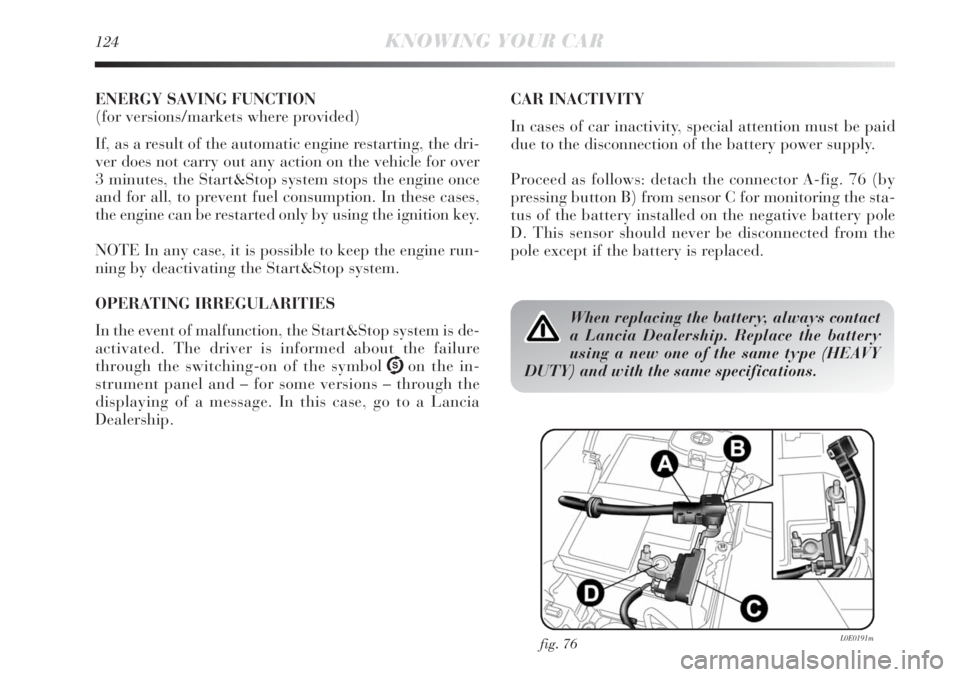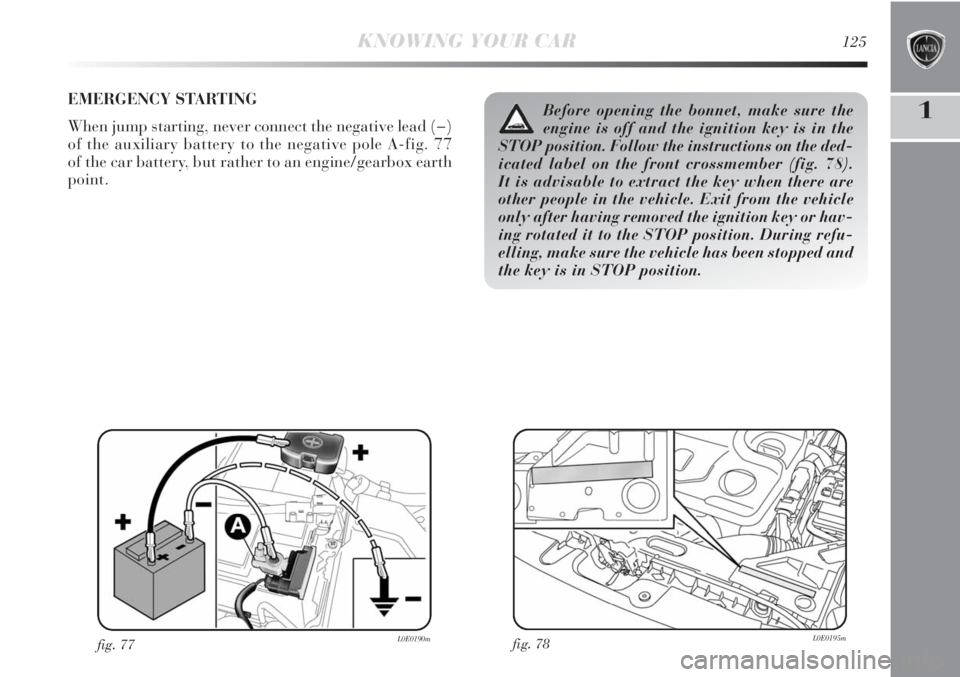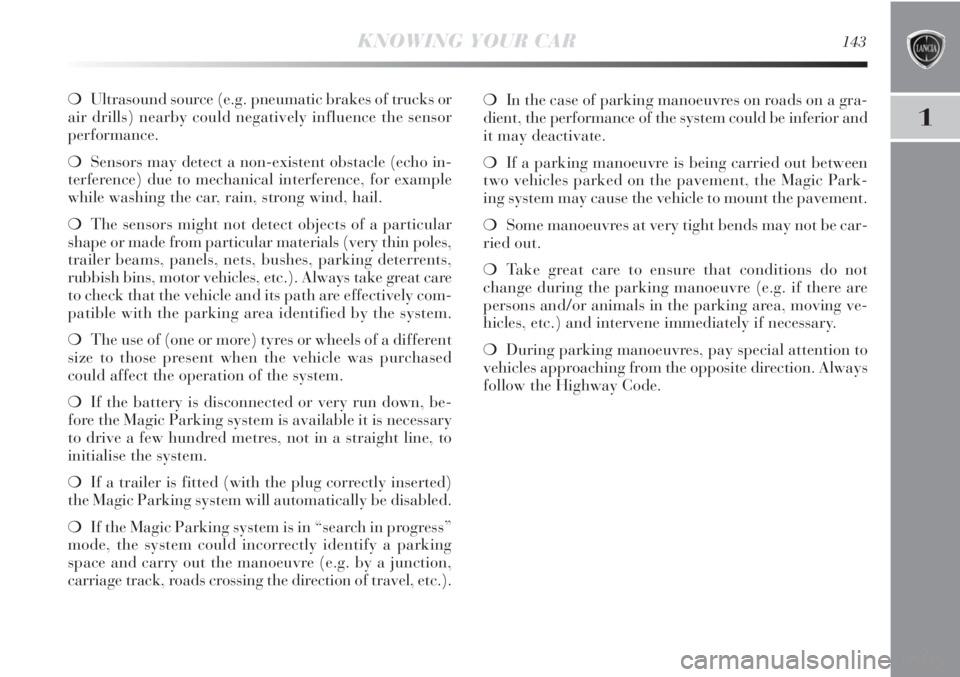battery Lancia Delta 2012 Owner handbook (in English)
[x] Cancel search | Manufacturer: LANCIA, Model Year: 2012, Model line: Delta, Model: Lancia Delta 2012Pages: 295, PDF Size: 8.29 MB
Page 88 of 295

86KNOWING YOUR CAR
fig. 50L0E0109m
INITIALISATION PROCEDURE
After the battery has been disconnected or a fuse has
blown, the operation of the sun roof must be initialised
again.
Proceed as follows:
âpress button A-fig. 49 until the sun roof is completely
closed. Release the button;
âpress and hold down button A for at least 10 seconds
and/or until the glass panel moves forwards by one
click. Release the button at this point;
âpress button A within 5 seconds of this operation and
keep it pressed: the glass panel will complete a full
opening and closing cycle. Release the button only at
the end of this cycle.EMERGENCY OPERATION
If the switch does not work, the sunroof can be operated
manually as follows:
âremove protective cap A-fig. 50 on the rear part of the
internal cover;
âtake the Allen key provided from the container with
the on-board documentation or from the luggage
compartment (versions with Fix&Go automatic);
âfit the key into seat B and turn it:
â clockwise to open the roof;
â anticlockwise to close the roof.
Page 92 of 295

90KNOWING YOUR CAR
IMPORTANT If the battery is disconnected or the pro-
tection fuse blows, the luggage compartment opening/
closing mechanism must be initialised as follows:
âshut all the doors;
âpress button
Ăon the key or door lock/release but-
ton
âin the dashboard;
âpress button
Ăon the key or door lock/release but-
ton
âin the dashboard.
If the child lock was engaged and the previ-
ously described locking procedure carried
out, operating the internal handle will not
open the door but will only realign the door lock
knobs. To open the door, the outside handle must be
used. The door central locking/unlocking button is
not disabled by the engagement of the emergency
lock
â.
POWER WINDOWS
These operate when the ignition key is turned to MAR and
for about 2 minutes after turning the key to STOP or re-
moving it.
The control buttons are located in the door panels (the
driver side door panel can be used to operate all the
windows).
An anti-pinch device is operated when the front windows
are lifted.
CONTROLS fig. 54
A. opening/closing left hand front window; âcontinuous
automaticâ operation during window opening/closing
stage;
B. opening/closing right hand front window; âcontinu-
ous automaticâ operation during window opening/
closing stage;
C. enabling/disabling of rear door electric window con-
trols;
D. opening/closing left hand rear window (for versions/
markets, where provided); âcontinuous automaticâ
operation during window opening/closing stage;
E.opening/closing right hand rear window (where pro-
vided); âcontinuous automaticâ operation during win-
dow opening/closing stage.
Page 95 of 295

1
KNOWING YOUR CAR93
Electric window system initialisation
The system must be re-initialised after disconnecting the
battery or if the relevant protection fuse is blown.
Initialisation procedure:
âfully close the window to be initialised manually;
âonce fully closed, keep holding down the closing con-
trol for at least 1 second.
IMPORTANT Where provided, after there has been no
power supply for the control units (battery replaced or
disconnected or protective fuses for the electric window
control units replaced), the automatic operation of the
windows must be restored.The restoration procedure must be performed as follows
with the doors closed:
1. completely open the driverâs door window keeping the
operating button pressed for at least three seconds af-
ter the (lower) end of travel position;
2. completely raise the driverâs side window and keep the
button pressed for at least three seconds once the end
of travel position (upper end stop) has been reached;
3. repeat stages 1 and 2 for the passenger-side window
4. make sure that the initialisation is correct by check-
ing that the windows work automatically.
IMPORTANT With central locking on, operating the in-
ternal handle of one of the doors will unlock all the doors.
If there is no electric power supply (fuse blown, battery
disconnected, etc.) it is still possible to operate the door
locking manually; in this case the automatic lowering
function for the windows is not available and to open or
close the door with the window closed it is necessary to
exert pressure on the window towards the inside of the
vehicle to facilitate the movement of the window on the
moulding.
Page 98 of 295

96KNOWING YOUR CAR
fig. 57L0E0048m
OPENING THE TAILGATE IN AN EMERGENCY
fig. 57
To open the tailgate from the passenger compartment if
the car battery is flat or the electric tailgate lock is faulty,
proceed as follows (see âExtending the bootâ).
âremove the rear head restraints;
âfold over the backrests;
âoperate lever A to unlock the tailgate mechanically
from inside the luggage compartment.EXTENDING THE BOOT
IMPORTANT If the rear seat backrest is folded down, re-
leasing the rear curtains of the parcel shelf is strictly com-
pulsory (follow the specific indications in the âParcel
shelfâ paragraph).
The luggage compartment can be partially (1/3 or 2/3)
or totally extended by splitting the rear seat fig. 58.
Page 124 of 295

122KNOWING YOUR CAR
Start&Stop system activation
A message and a symbol will be displayed when the
Start&Stop system is on. In this condition, the LED
A-fig. 75 on the button Tis off.
Turning the Start&Stop off
Versions with reconfigurable multifunction display: the
Tsymbol will appear on the display when the Start&Stop
system is off.
When the system is deactivated, the LED A-fig. 75 is on.ENGINE STOPPING FAILURE CONDITIONS
When the system is operating, due to comfort, emission
control and safety reasons, the engine does not stop in
some conditions, among which:
âengine still cold;
âespecially cold outside temperature;
âbattery not sufficiently charged;
âheated rear window activated;
âdriverâs door not shut;
âdriverâs seat belt not fastened;
âreverse gear engaged (for example, during parking
manoeuvres);
âfor versions equipped with dual zone automatic cli-
mate control (for versions/markets, where provided),
if an adequate level of thermal comfort has not been
reached or MAX-DEF function activation;
âduring the first period of use, to initialise the system.
In these cases, the display shows a message and â for
those versions/markets where provide â the symbol U
on the instrument panel display flashes.
If the climate comfort is to be favoured, the
Start&Stop system can be deactivated, for
a continuous operation of the climate control system.
Page 125 of 295

1
KNOWING YOUR CAR123
ENGINE RESTARTING CONDITIONS
For reasons of comfort, limiting harmful emissions and
safety purposes, the power unit can restart automatically
without any action on behalf of the driver if certain con-
ditions are met, including:
âbattery not sufficiently charged;
âreduced braking system pressure, e.g. following the
brake pedal being pressed repeatedly;
âcar moving (e.g. when driving on roads with a gra-
dient);
âengine stopping by Start&Stop system for over 3 min-
utes;
âfor versions equipped with dual zone automatic cli-
mate control (for versions/markets where provided),
to enable suitable thermal comfort or MAX-DEF
function activation.
With gear engaged, automatic engine restarting is possi-
ble only by fully pressing the clutch pedal.
The driver is informed by the displaying of a message and
â for versions/markets where provided â by the flashing
of the symbol U.Notes
If the clutch is not pressed, after 3 minutes from the en-
gine stopping, the engine can be restarted only using the
ignition key.
In cases when the engine stops and this is not desired, due
for example to the clutch pedal being released sharply
with a gear engaged, if the Start&Stop system is acti-
vated, the engine can be restarted by fully depressing the
clutch pedal or by placing the gear lever in neutral
SAFETY FUNCTIONS
When the engine is stopped by the Start&Stop system,
if the driver releases his/her seat belt and opens the dri-
verâs or passengerâs door, the engine can be restarted only
using the ignition key.
The driver is informed by a buzzer and by the flashing
of the symbol Uon the display; on some versions, a mes-
sage is displayed as well.
Page 126 of 295

124KNOWING YOUR CAR
ENERGY SAVING FUNCTION
(for versions/markets where provided)
If, as a result of the automatic engine restarting, the dri-
ver does not carry out any action on the vehicle for over
3 minutes, the Start&Stop system stops the engine once
and for all, to prevent fuel consumption. In these cases,
the engine can be restarted only by using the ignition key.
NOTE In any case, it is possible to keep the engine run-
ning by deactivating the Start&Stop system.
OPERATING IRREGULARITIES
In the event of malfunction, the Start&Stop system is de-
activated. The driver is informed about the failure
through the switching-on of the symbol Uon the in-
strument panel and â for some versions â through the
displaying of a message. In this case, go to a Lancia
Dealership.CAR INACTIVITY
In cases of car inactivity, special attention must be paid
due to the disconnection of the battery power supply.
Proceed as follows: detach the connector A-fig. 76 (by
pressing button B) from sensor C for monitoring the sta-
tus of the battery installed on the negative battery pole
D. This sensor should never be disconnected from the
pole except if the battery is replaced.
fig. 76L0E0191m
When replacing the battery, always contact
a Lancia Dealership. Replace the battery
using a new one of the same type (HEAVY
DUTY) and with the same specifications.
Page 127 of 295

1
KNOWING YOUR CAR125
EMERGENCY STARTING
When jump starting, never connect the negative lead (â)
of the auxiliary battery to the negative pole A-fig. 77
of the car battery, but rather to an engine/gearbox earth
point.
fig. 77L0E0190mfig. 78L0E0195m
Before opening the bonnet, make sure the
engine is off and the ignition key is in the
STOP position. Follow the instructions on the ded-
icated label on the front crossmember (fig. 78).
It is advisable to extract the key when there are
other people in the vehicle. Exit from the vehicle
only after having removed the ignition key or hav-
ing rotated it to the STOP position. During refu-
elling, make sure the vehicle has been stopped and
the key is in STOP position.
Page 145 of 295

1
KNOWING YOUR CAR143
âUltrasound source (e.g. pneumatic brakes of trucks or
air drills) nearby could negatively influence the sensor
performance.
âSensors may detect a non-existent obstacle (echo in-
terference) due to mechanical interference, for example
while washing the car, rain, strong wind, hail.
âThe sensors might not detect objects of a particular
shape or made from particular materials (very thin poles,
trailer beams, panels, nets, bushes, parking deterrents,
rubbish bins, motor vehicles, etc.). Always take great care
to check that the vehicle and its path are effectively com-
patible with the parking area identified by the system.
âThe use of (one or more) tyres or wheels of a different
size to those present when the vehicle was purchased
could affect the operation of the system.
âIf the battery is disconnected or very run down, be-
fore the Magic Parking system is available it is necessary
to drive a few hundred metres, not in a straight line, to
initialise the system.
âIf a trailer is fitted (with the plug correctly inserted)
the Magic Parking system will automatically be disabled.
âIf the Magic Parking system is in âsearch in progressâ
mode, the system could incorrectly identify a parking
space and carry out the manoeuvre (e.g. by a junction,
carriage track, roads crossing the direction of travel, etc.).âIn the case of parking manoeuvres on roads on a gra-
dient, the performance of the system could be inferior and
it may deactivate.
âIf a parking manoeuvre is being carried out between
two vehicles parked on the pavement, the Magic Park-
ing system may cause the vehicle to mount the pavement.
âSome manoeuvres at very tight bends may not be car-
ried out.
âTake great care to ensure that conditions do not
change during the parking manoeuvre (e.g. if there are
persons and/or animals in the parking area, moving ve-
hicles, etc.) and intervene immediately if necessary.
âDuring parking manoeuvres, pay special attention to
vehicles approaching from the opposite direction. Always
follow the Highway Code.
Page 180 of 295

178STARTING AND DRIVING
ENGINE STARTING
The car is fitted with an electronic engine lock device: if
the engine fails to start, see the paragraph on âLancia
CODE systemâ in chapter â1â.
The engine may be noisier during the first few seconds of
operation, especially after a long period of inactivity. This
characteristic feature of the hydraulic tappet system does
not compromise functionality or reliability: the system
devised for your car was designed to limit maintenance
interventions.
In the first period of use, we recommend
avoiding excessive stress for the car (for in-
stance excessive accelerations, extended
travel at maximum speed, sudden braking etc.).
With engine off, do not leave the key in the
ignition switch on MARâON to prevent
draining the battery.
It is dangerous to let the engine run in en-
closed spaces. The engine consumes oxygen
and engine exhaust contains carbon dioxide,
carbon monoxide and other toxic gasses.
Remember that the brake servo and power
steering are not operational until the engine
has been started, therefore much effort than
usual is required on the brake pedal and steering
wheel.
STARTING PROCEDURE FOR PETROL VERSIONS
Proceed as follows:
âengage the handbrake;
âput the gear lever into neutral;
âfully depress the clutch pedal without operating the
accelerator;
âturn the ignition key to AVV and release it as soon
as the engine starts.